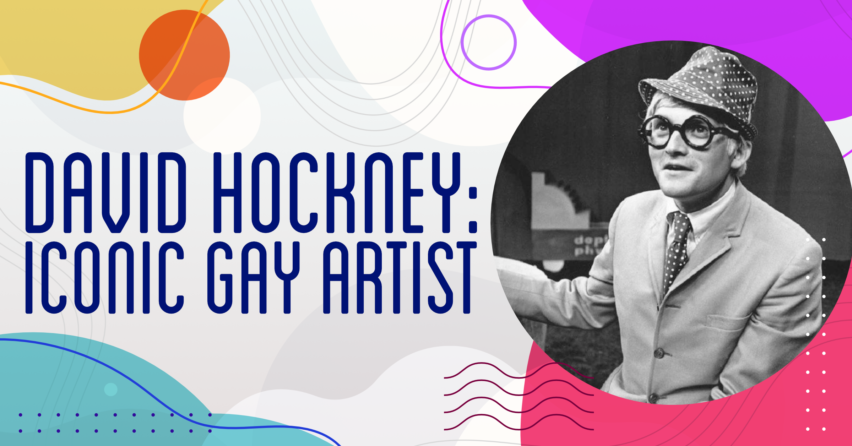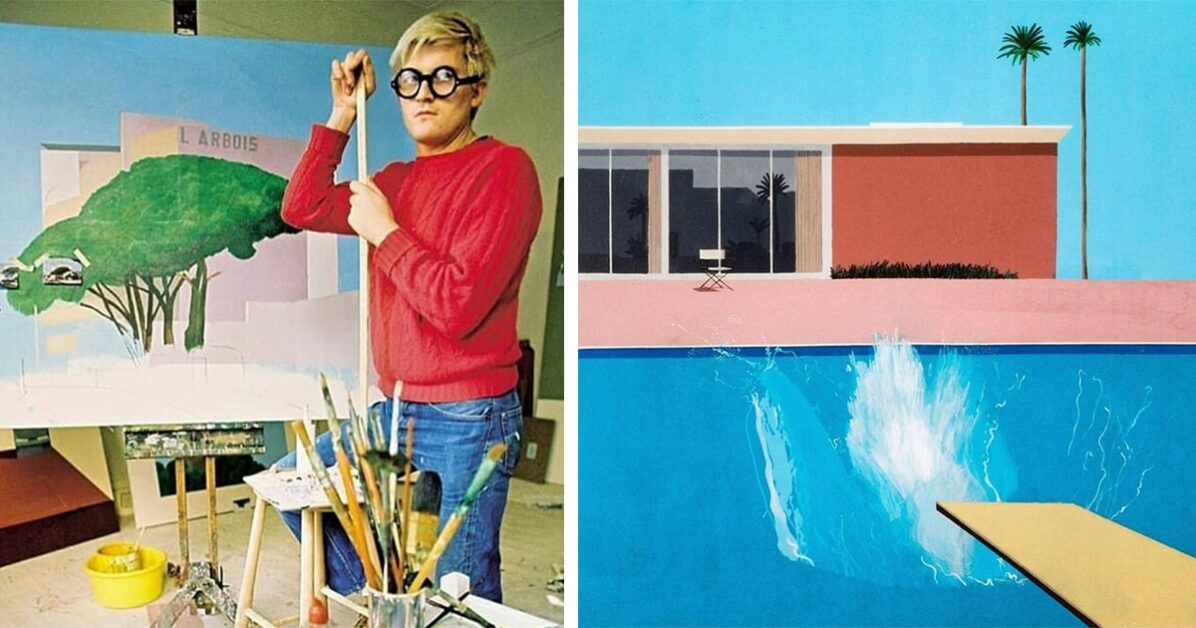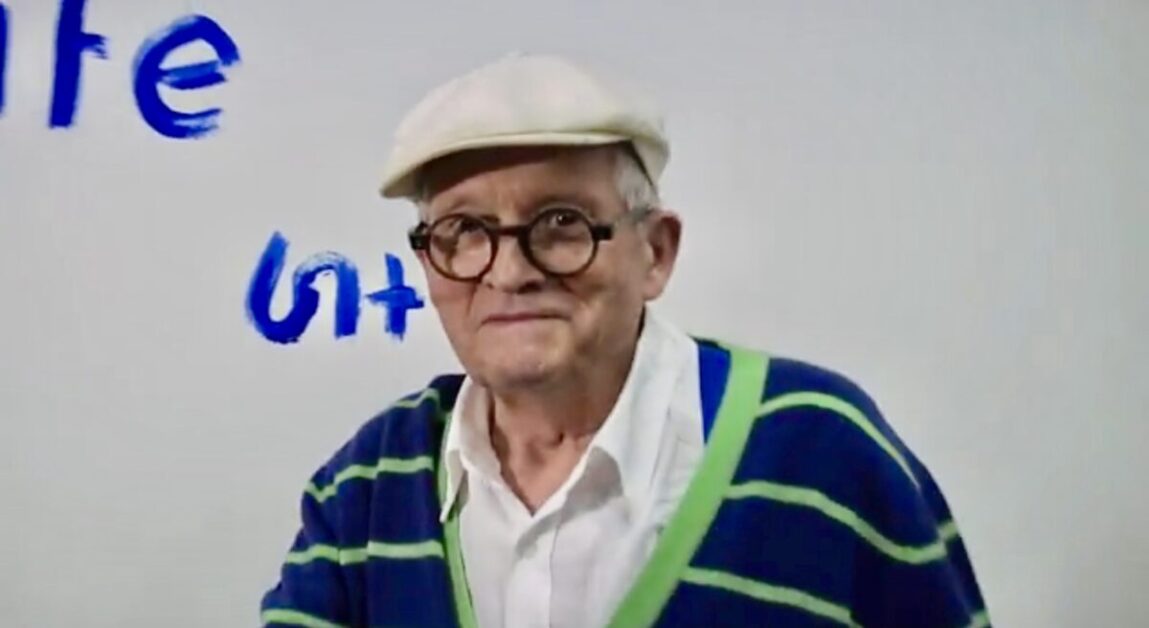David Hockney: Iconic Gay Artist
by Siobhan Donegan
David Hockney has been described as one of the most influential artists of the 20th century. He is a painter, an illustrator, a photographer, a printmaker, stage set designer and draftsman. He is also gay which I will talk about slightly later in the article. Hockney is perhaps best known for a series of paintings of swimming pools rendered in striking colours using the relatively new medium, at the time, of acrylic, which were composed after he had moved to Los Angeles in 1964. However, it has been said that there is a lot more to David Hockney than just swimming pools. For example, these paintings reflect his sunny Californian lifestyle whereas when residing in England he likes to paint the seasons.
His preoccupation with light and its effects was apparently derived and inspired by the intense Californian light in L.A which became a major influence on his work. However, although his compositions have made use of vibrant colours, his paintings have also been described as having a preoccupation with ‘mundane realism’, which has derived inspiration partially from Pop art and photography.
David Hockney was the fourth child of five and was born in Bradford, West Riding of Yorkshire in 1937, his parents being Laura and Kenneth Hockney. His artwork featured in the exhibition Young Contemporaries at the Royal College of Art together with famous British Pop Artist Peter Blake. In fact, this exhibition heralded the beginnings and arrival of British Pop art. The genre of Pop art was a movement that involved many young artists, and can thus probably be seen in the wider context of the youth movement at the time, who felt that a lot of the artwork on show in galleries was a bit boring. As such Hockney has been associated with this artistic genre-movement.
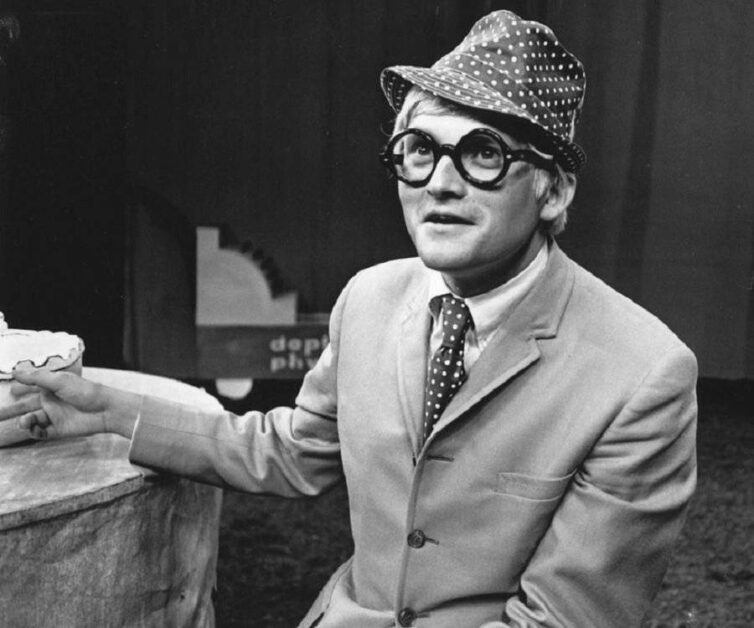 From 1953 to 57, Hockney was a student at the Bradford College of Art and studied in London from 1959 to 62 at the Royal College of Art. He went to the U.S.A for the first time in 1961. Hockney also worked in America as a teacher at the Universities of Iowa, California and Colorado from the years 1964 to 67. From this point onwards, he was a regular visitor to the States-commuting back and forth from England-before he decided to permanently settle in Los Angeles in 1978.
From 1953 to 57, Hockney was a student at the Bradford College of Art and studied in London from 1959 to 62 at the Royal College of Art. He went to the U.S.A for the first time in 1961. Hockney also worked in America as a teacher at the Universities of Iowa, California and Colorado from the years 1964 to 67. From this point onwards, he was a regular visitor to the States-commuting back and forth from England-before he decided to permanently settle in Los Angeles in 1978.
Returning to the subject of his artwork, Hockney is known for using ‘autobiographical’ subject matter for his compositions of ‘incidental scenes’, referencing friends and his living quarters. Often there is a confident ‘elegance’ and a summery tranquillity to the scenes portrayed. A well-known painting in this style is ‘Portrait of an Artist (Pool with Two Figures)’ (1972).
This painting actually sold at Christies Auction House (New York) for 90 million dollars (70 million pounds), on 15 November 2018. At the time, this was the most expensive piece of artwork sold at auction ‘by a living Artist’ and broke the previous record held by Jeff Koons from 2013. Jeff Koons went on to reclaim the record in 2019 when his ‘Rabbit’ sold for 91 million dollars at Christies.
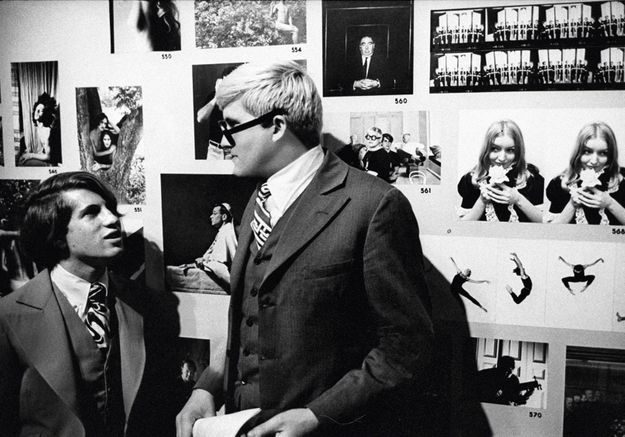
As mentioned above Hockney is also gay, which he has understandably explored as a subject matter in his artwork. For example, the theme of gay love is referenced in his work ‘We Two Boys Together Clinging’ (1961), specifically named after a poem by Walt Whitman. Another portraiture work that visually explores love between men is the painting ‘Domestic Scene, Los-Angeles’ (1963), which depicts one man showering whilst another washes his back.
Hockney met Peter Schlesinger, an Art student, in 1966 with whom he became romantically involved. He met Schlesinger while teaching at the UCLA; Schlesinger had been modelling for paintings and drawings at the time.
As mentioned at the beginning of this article, Hockney has also explored the medium of photography, most notably in the 1980’s, and is also known for his photo collages. A good example of this artistic endeavour being photo collage ‘Pear-blossom Hwy’ (1986), which is in fact one of a number of collages that have been described as ‘ambitious’.
Also, as previously mentioned Hockney has artistically expressed himself as a stage-set designer, specifically for the Opera and Ballet for which he is described as having ‘achieved international prominence’.
If the above list of artistic achievements were not already impressive, Hockney has also tried his hand at working as an illustrator, his illustrations having been published in ‘several series of graphic works in book form’. These illustrations include, ‘Six Fairy Tales of the Brothers Grimm’, 1970 and ‘The Blue Guitar’, 1977.

David Hockney has also embraced the new technology available for artists in the latter years of his life, specifically the Brushes App. With this, he has apparently produced still life compositions, landscapes and portraits. Hockney stated, ‘When I began drawing on an I-pad I loved it’. According to Artnet-which interviewed Hockney-he stated,
‘I thought it was a terrific medium. Everything is at your fingertips, there’s no cleaning up. I realised I could just reach for my I-phone and draw, even in the dark.’
Hockney has used a hearing aid since 1979 and has ‘Synaesthetic associations’-‘between’ sound and colour. Interestingly I have come across this ‘phenomena’ before, but in a completely different context; Synaesthesia can be a state of consciousness induced by drugs or states of deep meditation in which a person can ‘hear’ colours and ‘see’ sounds. I should think that with an artist of Hockney’s creative genius, this could be of benefit to his creative process.
This seems to be the case, as synaesthesia reportedly affects Hockney by allowing him to see colours as a result of ‘musical stimuli’. This has inspired the creative process of his set designs for the Ballet and Opera as he often designs his sets in colours ‘matched’ to the musical pieces that are to be performed.
David Hockney has had a sixty-year career as an artist. Ironically, considering the fact that he is famous for his artistic renditions of swimming pools, he actually keeps fit by swimming for half an hour each morning. This regime has obviously been working, as he is able to stand at his easel for six hours.
